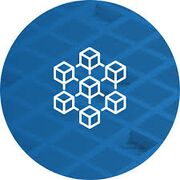Différences entre versions de « Blockchain Technology »
| Ligne 49 : | Ligne 49 : | ||
<!-- *************** Commercez les modifications *******************--> | <!-- *************** Commercez les modifications *******************--> | ||
| − | * | + | * Blockchain |
| − | + | ||
| − | + | • Blockchains are distributed digital ledgers of cryptographically signed transactions that are grouped into “blocks” | |
| − | + | ||
| − | + | • Each block is “cryptographically” linked to the previous one after validation and undergoing a “consensus” decision | |
| − | + | ||
| − | + | • As new blocks are added, older blocks become more difficult to modify | |
| − | + | ||
| − | + | • New blocks are replicated across all copies of the ledger within the network, and any conflicts are resolved automatically using established rules | |
| − | + | ||
| − | + | ||
| Ligne 67 : | Ligne 67 : | ||
|Typologie= <!------------------------------------ Ne pas Modifier --> | |Typologie= <!------------------------------------ Ne pas Modifier --> | ||
<!-- ****************** Commercez les modifications ****************--> | <!-- ****************** Commercez les modifications ****************--> | ||
| + | |||
| + | * First Blockchain | ||
| + | |||
| + | • Bitcoin is the world’s premier blockchain | ||
| + | |||
| + | • Launched in 2009 by an anonymous person (or a group of persons) known by the name of Satoshi Nakamoto | ||
| + | |||
| + | • Suspiciously around the time of the Subprime crisis | ||
| + | |||
| + | • First successful peer-to-peer electronic cash system | ||
| + | |||
| + | • Bitcoin illustrates how we use blockchain to maintain a history of valid transactions that are tamper-resistant, without any effort from central authority | ||
| + | |||
*Centralized Systems | *Centralized Systems | ||
# Homogeneous | # Homogeneous | ||
Version du 26 mai 2022 à 19:44
 Traduction
Traduction
 Définition
Définition
Domaine, Discipline, Thématique
Définition écrite
- Blockchain
• Blockchains are distributed digital ledgers of cryptographically signed transactions that are grouped into “blocks”
• Each block is “cryptographically” linked to the previous one after validation and undergoing a “consensus” decision
• As new blocks are added, older blocks become more difficult to modify
• New blocks are replicated across all copies of the ledger within the network, and any conflicts are resolved automatically using established rules
• Bitcoin is the world’s premier blockchain • Launched in 2009 by an anonymous person (or a group of persons) known by the name of Satoshi Nakamoto • Suspiciously around the time of the Subprime crisis • First successful peer-to-peer electronic cash system • Bitcoin illustrates how we use blockchain to maintain a history of valid transactions that are tamper-resistant, without any effort from central authority
|
Définition graphique
 Concepts ou notions associés
Concepts ou notions associés
 Exemples, applications, utilisations
Exemples, applications, utilisations
• Performance • Scalability • Redundancy (for fault-tolerance) • How to ensure consistency among nodes of a distributed system? • Even if some aren’t reliable nor honest? • Trust without trust? • Requires a way to reach “consensus”
• For a centralized database system, one central entity handles all requests and data processing • Data updates simple and quick • Cheaper to manage and maintain • Performance bottleneck under high concurrent requests • Single point of failure
• A group of databases cooperating together to provide single data view to users • Fault-tolerant • Handle more concurrent load • Requires “trust” among nodes (• Not a problem if owned by a single enterprise, • For nodes not fully trusting each other, a “consensus” protocol is required to keep a consistent view of data)
• A type of distributed database system • Immutable, append-only database of transactions (for example, exchanges of assets or data) • Ledgers are replicated, synchronized and shared across all nodes in the distributed, peer-to-peer network • Nodes reach consensus on transaction updates to its own copy of ledger, thus maintaining consistent ledger state • Via consensus protocol, this is achievable without central authority or trusted 3rd party mediator |
 Erreurs ou confusions éventuelles
Erreurs ou confusions éventuelles
- Confusion entre ....... - ........
- Confusion entre ....... - ........
- Erreur fréquente: ....................
 Questions possibles
Questions possibles
 Liaisons enseignements et programmes
Liaisons enseignements et programmes
Idées ou Réflexions liées à son enseignement
Aides et astuces
Education: Autres liens, sites ou portails
 Bibliographie
Bibliographie
Pour citer cette page: (Technology)
ABROUGUI, M & al, 2022. Blockchain Technology. In Didaquest [en ligne]. <http:www.didaquest.org/wiki/Blockchain_Technology>, consulté le 21, novembre, 2024
- ..................
- ..................
- ..................
- ..................
- Sponsors Education
- Blockchain Technology (Concepts)
- Centralized Systems (Concepts)
- Distributed Systems (Concepts)
- Distributed Ledger Technology (DLT) (Concepts)
- Distributed Ledger in Bitcoin Network (Concepts)
- Bitcoin (Concepts)
- Ethereum (Concepts)
- Non-Public Blockchains (Concepts)
- Big Consortia (Concepts)
- Blockchain Technology
- Bitcoin Mechanics
- Ethereum
- PoW vs PoS consensus
- Consensus models
- Enterprise Blockchain
- Blockchain Scaling
- Stablecoins
- Concepts
- Fiche conceptuelle didactique





